Taisir E. H. El-Gorashi
Two-Agent DRL for Power Allocation and IRS Orientation in Dynamic NOMA-based OWC Networks
Apr 26, 2025Abstract:Intelligent reflecting surfaces (IRSs) technology has been considered a promising solution in visible light communication (VLC) systems due to its potential to overcome the line-of-sight (LoS) blockage issue and enhance coverage. Moreover, integrating IRS with a downlink non-orthogonal multiple access (NOMA) transmission technique for multi-users is a smart solution to achieve a high sum rate and improve system performance. In this paper, a dynamic IRS-assisted NOMA-VLC system is modeled, and an optimization problem is formulated to maximize sum energy efficiency (SEE) and fairness among multiple mobile users under power allocation and IRS mirror orientation constraints. Due to the non-convex nature of the optimization problem and the non-linearity of the constraints, conventional optimization methods are impractical for real-time solutions. Therefore, a two-agent deep reinforcement learning (DRL) algorithm is designed for optimizing power allocation and IRS orientation based on centralized training with decentralized execution to obtain fast and real-time solutions in dynamic environments. The results show the superior performance of the proposed DRL algorithm compared to standard DRL algorithms typically used for resource allocation in wireless communication. The results also show that the proposed DRL algorithm achieves higher performance compared to deployments without IRS and with randomly oriented IRS elements.
Energy Efficient Service Placement for IoT Networks
Apr 25, 2024Abstract:In recent years, there has been a significant expansion in the Internet of Things (IoT), with a growing number of devices being connected to the internet. This has led to an increase in data collection and analysis as well as the development of new technologies and applications. The rise of IoT has also brought about new challenges, such as security concerns and energy efficiency. This study investigates a layered IoT architecture that combines fog and cloud computing, aiming to assess the impact of service placement on energy efficiency. Through simulations, we analyse energy use across Access Fog, Metro Fog, and Cloud Data Centre layers for different IoT request volumes. Findings indicate that Access Fog is optimal for single requests, while Metro Fog efficiently manages higher demands from multiple devices. The study emphasizes the need for adaptive service deployment, responsive to network load variations, to improve energy efficiency. Hence, we propose the implementation of dynamic service placement strategies within Internet of Things (IoT) environments.
A Novel Terabit Grid-of-Beam Optical Wireless Multi-User Access Network With Beam Clustering
Apr 05, 2024

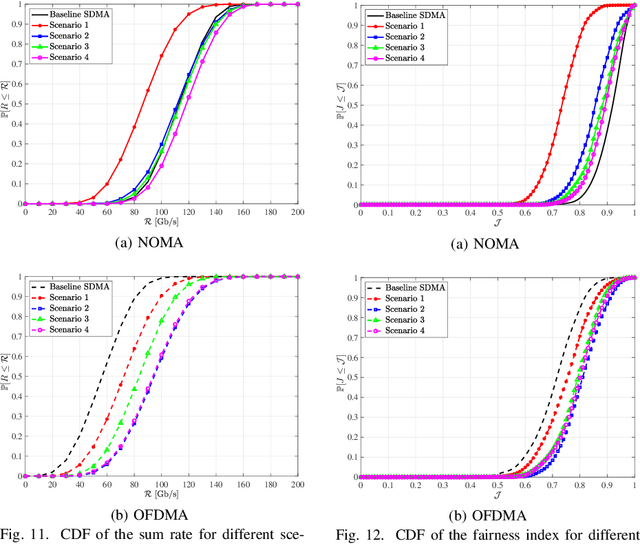
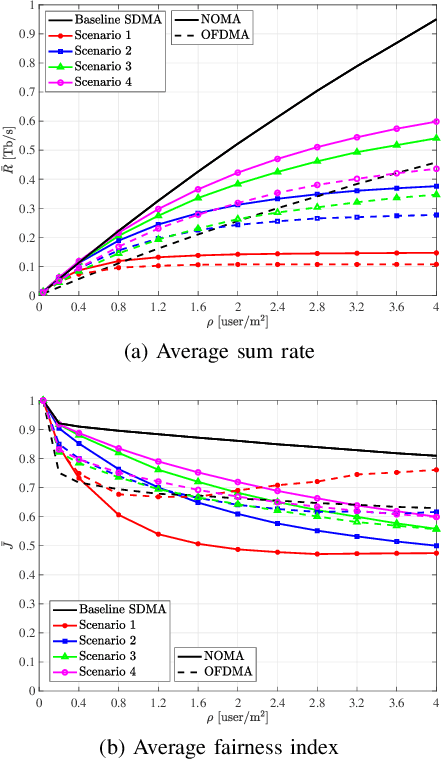
Abstract:In this paper, we put forward a proof of concept for sixth generation (6G) Terabit infrared (IR) laser-based indoor optical wireless networks. We propose a novel double-tier access point (AP) architecture based on an array of arrays of vertical cavity surface emitting lasers (VCSELs) to provide a seamless grid-of-beam coverage with multi-Gb/s per beam. We present systematic design and thorough analytical modeling of the AP architecture, which are then applied to downlink system modeling using non-imaging angle diversity receivers (ADRs). We propose static beam clustering with coordinated multi-beam joint transmission (CoMB-JT) for network interference management and devise various clustering strategies to address inter-beam interference (IBI) and inter-cluster interference (ICI). Non-orthogonal multiple access (NOMA) and orthogonal frequency division multiple access (OFDMA) schemes are also adopted to handle intra-cluster interference, and the resulting signal-to-interference-plus-noise ratio (SINR) and achievable data rate are derived. The network performance is studied in terms of spatial distributions and statistics of the downlink SINR and data rate through extensive computer simulations. The results demonstrate that data rates up to 15 Gb/s are achieved within the coverage area and a properly devised clustering strikes a balance between the sum rate and fairness depending on the number of users.
Intelligent Reflecting Surfaces assisted Laser-based Optical Wireless Communication Networks
Apr 02, 2024Abstract:The increasing demand for wireless networks of higher capacity requires key-enabling technologies. Optical wireless communication (OWC) arises as a complementary technology to radio frequency (RF) systems that can support high aggregate data rates. However, OWC systems face some challenges including beam-blockage. Intelligent reflecting surfaces (IRSs) can offer alternative pathways for the optical signal, ensuring continuous connectivity. In this work, we investigate the potential of using IRS in an indoor OWC network. In particular, we define a system model of indoor OWC that employs IRS in conjunction with angle diversity transmitters (ADT) using vertical-cavity surface-emitting laser (VCSEL) arrays. The VCSEL beam is narrow, directed, and easy to block, however, it can deliver high data rates under eye safety regulations. Simulation results show that the deployment of IRS can significantly improve the achievable data rates of Laser-based OWC systems.
Multiuser beam steering OWC system based on NOMA
Apr 10, 2023Abstract:In this paper, we propose applying Non-Orthogonal Multiple Access (NOMA) technology in a multiuser beam steering OWC system. We study the performance of the NOMA-based multiuser beam steering system in terms of the achievable rate and Bit Error Rate (BER). We investigate the impact of the power allocation factor of NOMA and the number of users in the room. The results show that the power allocation factor is a vital parameter in NOMA-based transmission that affects the performance of the network in terms of data rate and BER.
Relay Assisted Multiuser OWC Systems under Human Blockage
Apr 10, 2023Abstract:This paper proposes using cooperative communication based on optoelectronic (O-E-O) amplify-and-forward relay terminals to reduce the influence of the blockage and shadowing resulting from human movement in a beam steering Optical Wireless Communication (OWC) system. The simulation results indicate that on average, the outage probability of the cooperative communication mode with O-E-O relay terminals is two orders of magnitude lower than the outage probability of the system without relay terminals.
High-Speed Imaging Receiver Design for 6G Optical Wireless Communications: A Rate-FOV Trade-Off
May 11, 2022



Abstract:The design of a compact high-speed and wide field of view (FOV) receiver is challenging due to the presence of two well-known trade-offs. The first one is the area-bandwidth trade-off of photodetectors (PDs) and the second one is the gain-FOV trade-off due to the use of optics. The combined effects of these two trade-offs imply that the achievable data rate of an imaging optical receiver is limited by its FOV, i.e., a rate-FOV trade-off. To control the area-bandwidth trade-off, an array of small PDs can be used instead of a single PD. Moreover, in practice, a large-area lens is required to ensure sufficient power collection, which in turn limits the receiver FOV (i.e., gain-FOV trade-off). We propose an imaging receiver design in the form of an array of arrays. To achieve a reasonable receiver FOV, we use individual focusing lens for each PD array rather than a single collection lens for the whole receiver. The proposed array of arrays structure provides an effective method to control both gain-FOV trade-off (via an array of lenses) and area-bandwidth trade-off (via arrays of PDs). We first derive a tractable analytical model for the SNR of an array of PDs where the maximum ratio combining has been employed. Then, we extend the model for the proposed array of arrays structure and the accuracy of the analytical model is verified based on several Optic Studio-based simulations. Next, we formulate an optimization problem to maximize the achievable data rate of the imaging receiver subject to a minimum required FOV. The optimization problem is solved for two commonly used modulation techniques, namely, OOK and direct current biased optical orthogonal frequency division multiplexing with variable rate quadrature amplitude modulation. It is demonstrated that a data rate of ~ 24 Gbps with a FOV of 15 is achievable using OOK with a total receiver size of 2 cm by 2 cm.
Energy Efficient VM Placement in a Heterogeneous Fog Computing Architecture
Mar 27, 2022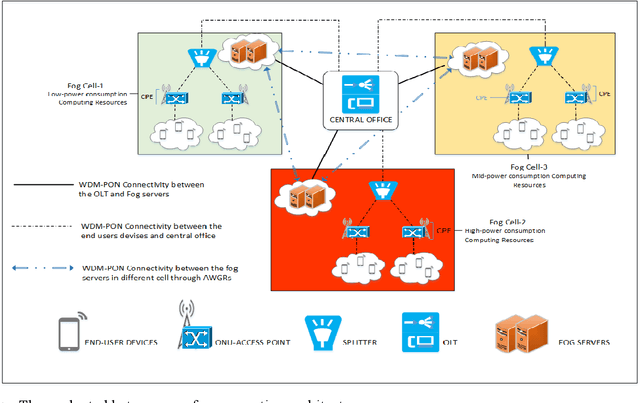
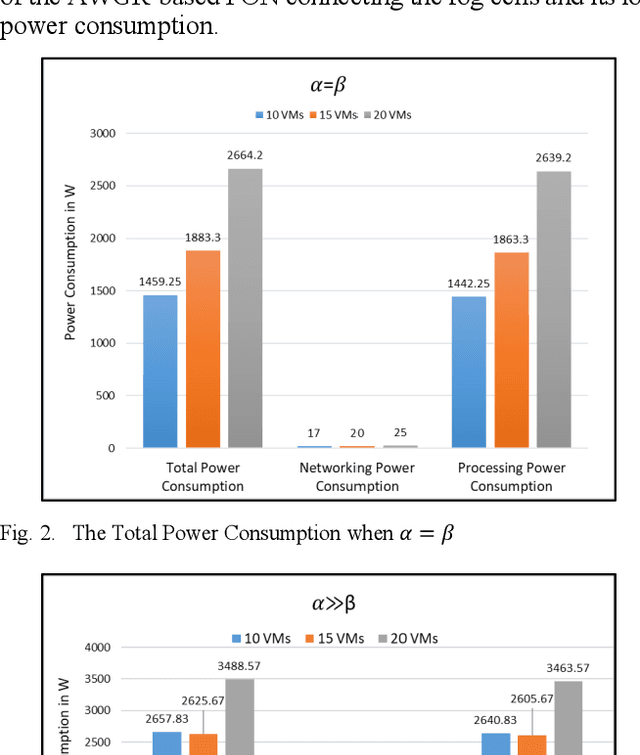
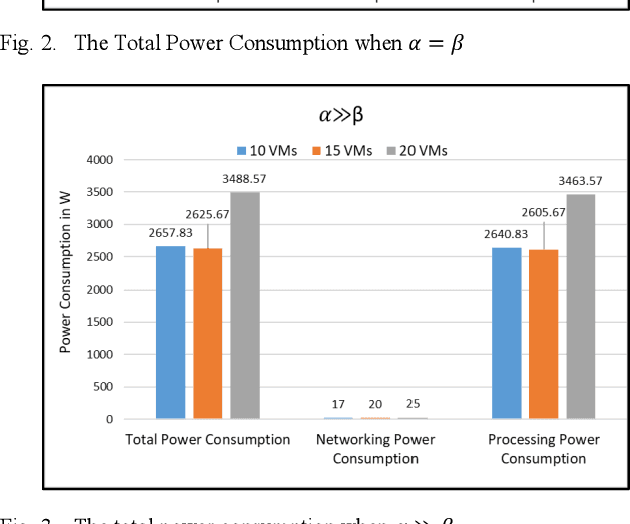
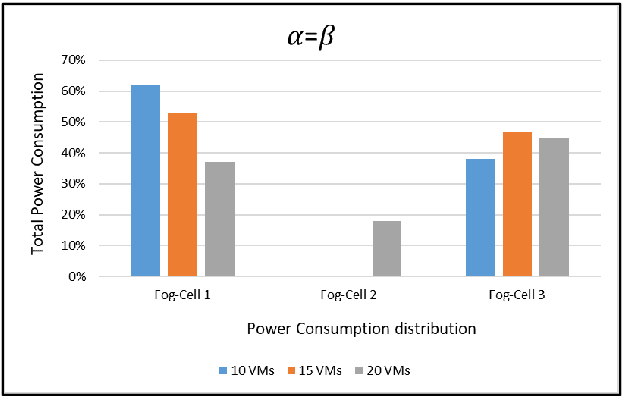
Abstract:Recent years have witnessed a remarkable development in communication and computing systems, mainly driven by the increasing demands of data and processing intensive applications such as virtual reality, M2M, connected vehicles, IoT services, to name a few. Massive amounts of data will be collected by various mobile and fixed terminals that will need to be processed in order to extract knowledge from the data. Traditionally, a centralized approach is taken for processing the collected data using large data centers connected to a core network. However, due to the scale of the Internet-connected things, transporting raw data all the way to the core network is costly in terms of the power consumption, delay, and privacy. This has compelled researchers to propose different decentralized computing paradigms such as fog computing to process collected data at the network edge close to the terminals and users. In this paper, we study, in a Passive Optical Network (PON)-based collaborative-fog computing system, the impact of the heterogeneity of the fog units capacity and energy-efficiency on the overall energy-efficiency of the fog system. We optimized the virtual machine (VM) placement in this fog system with three fog cells and formulated the problem as a mixed integer linear programming (MILP) optimization model with the objective of minimizing the networking and processing power consumption of the fog system. The results indicate that in our proposed architecture, the processing power consumption is the crucial element to achieve energy efficient VMs placement.
Random Linear Network Coding in NOMA Optical Wireless Networks
Feb 08, 2022



Abstract:Optical wireless communication (OWC) has the potential to provide high communication speeds that support the massive use of the Internet that is expected in the near future. In OWC, optical access points (APs) are deployed on the celling to serve multiple users. In this context, efficient multiple access schemes are required to share the resources among the users and align multi-user interference. Recently, non-orthogonal multiple access (NOMA) has been studied to serve multiple users simultaneously using the same resources, while a different power level is allocated to each user. Despite the acceptable performance of NOMA, users might experience a high packet loss due to high noise, which results from the use of successive interference cancelation (SIC). In this work, random linear network coding (RLNC) is proposed to enhance the performance of NOMA in an optical wireless network where users are divided into multicast groups, and each group contains users that slightly differ in their channel gains. Moreover, a fixed power allocation (FPA) strategy is considered among these groups to avoid complexity. The performance of the proposed scheme is evaluated in terms of total packet success probability. The results show that the proposed scheme is more suitable for the network considered compared to other benchmark schemes such as traditional NOMA and orthogonal transmission schemes. Moreover, the total packet success probability is highly affected by the level of power allocated to each group in all the scenarios.
Energy Efficient Resource Allocation in Federated Fog Computing Networks
Oct 28, 2021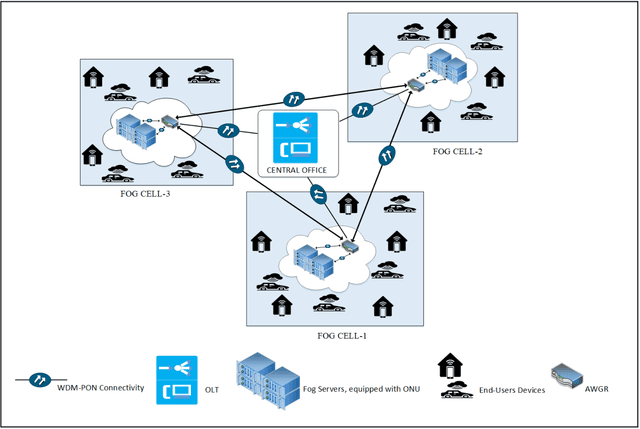
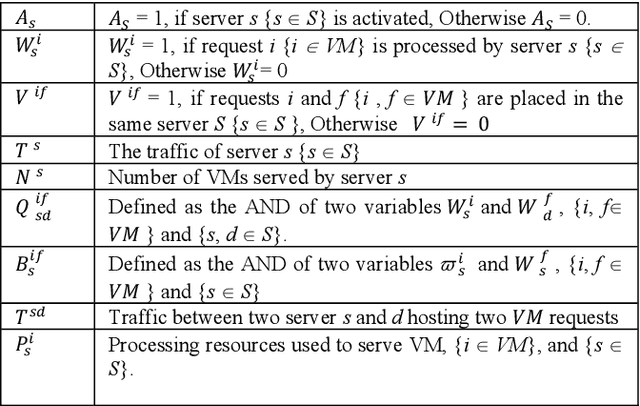
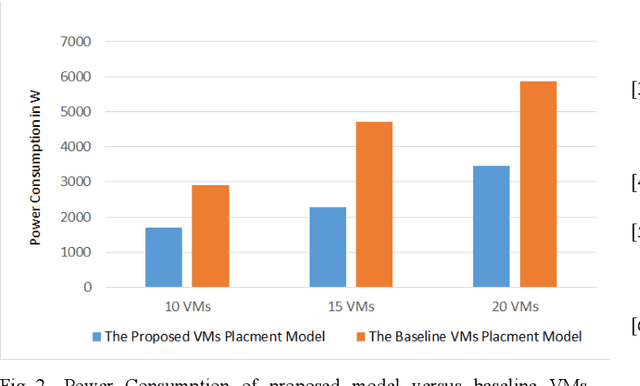
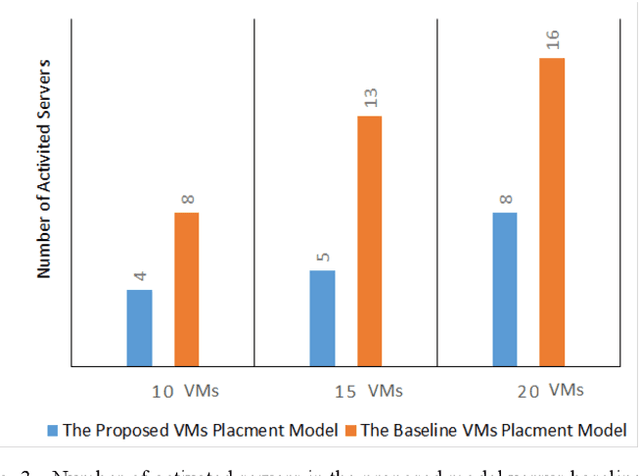
Abstract:There is a continuous growth in demand for time sensitive applications which has shifted the cloud paradigm from a centralized computing architecture towards distributed heterogeneous computing platforms where resources located at the edge of the network are used to provide cloud-like services. This paradigm is widely known as fog computing. Virtual machines (VMs) have been widely utilized in both paradigms to enhance the network scalability, improve resource utilization, and energy efficiency. Moreover, Passive Optical Networks (PONs) are a technology suited to handling the enormous volumes of data generated in the access network due to their energy efficiency and large bandwidth. In this paper, we utilize a PON to provide the connectivity between multiple distributed fog units to achieve federated (i.e. cooperative) computing units in the access network to serve intensive demands. We propose a mixed integer linear program (MILP) to optimize the VM placement in the federated fog computing units with the objective of minimizing the total power consumption while considering inter-VM traffic. The results show a significant power saving as a result of the proposed optimization model by up to 52%, in the VM-allocation compared to a baseline approach that allocates the VM requests while neglecting the power consumption and inter-VMs traffic in the optimization framework.
 Add to Chrome
Add to Chrome Add to Firefox
Add to Firefox Add to Edge
Add to Edge